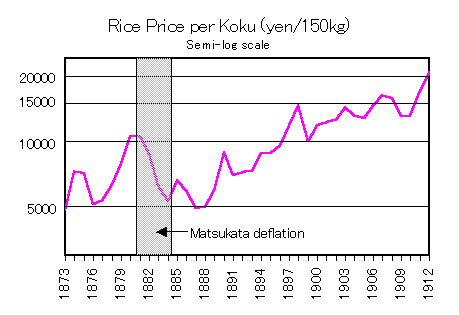Questions & Answers
Meiji 4
Here are questions raised by students in class and the
professor's answers.
Q1. China also introduced open door policy in the
1860s but could not build modern factories due to lack of funds. How did Meiji
Japan mobilize investment capital?
There were super businessmen like Shibusawa, Godai etc. who introduced the
Western system of joint stock companies and encouraged rich people to buy
stocks. Shibusawa also used his First "National" Bank to finance
working capital. These prominent business leaders played important roles in
implanting the stock company system. As silk and rice production enriched rural
Japan, self-finance by big farmers, landlords and merchants seem to have also
occurred. From the late 1880s, Japan experienced a series of "Company
Booms" during which many joint stock companies were formed (textiles,
railroads, etc). These were however mobilization of domestic savings. There was
virtually no foreign participation in establishing these companies.
Q2. Where did the domestic saving for Meiji
industrialization come from?
We don't have reliable statistics. According to Professor Juro Teranishi's
estimate, retained profits by the private business sector (commerce and
industry) were the largest. The second largest was inter-sectoral transfer from
agriculture (land tax) to industry. He doesn't have data before 1900, but land
tax may have been more important in early Meiji.
Q3. Is it correct to say that wars with China
(1894-95) and with Russia (1904-05) promoted Japan's industrialization?
As explained in class, these two wars had the effect of increasing the
economic size of government. After each war, the government became very
aggressive in industrial promotion and building infrastructure. Whether that was
beneficial for the long-term economic development of Japan is difficult to
judge. This fiscal activism also generated a macroeconomic problem
(balance-of-payment pressure and loss of gold reserves). But it is hard to deny
that a big government was a plus for rapid industrialization.
Q4. What was the tax structure like in Meiji?
Please wait
Q5. Please tell us about inflation and relative price shifts in the Meiji
period.
Japan's prewar overall price index starts from 1901, so we do not have a
reliable price index before that. But we can use the rice price to indicate the general
trend, as below.

Inflation and monetary confusion (which began in the port opening period, not
shown here) was terminated by finance minister Matsukata's deliberate deflation
policy. While this was the longest (3 years) and largest deflation, we can also
detect other smaller and shorter (usually 1 year) deflation episodes as well.
Throughout Meiji, the general trend in rice price was upward. By today's
standard, average annual inflation was mild, however.
For relative price shifts, please wait.
Q6. Has Japan never been a socialist economy?
Since Meiji (and even before that), Japan has never been a socialist economy
in the ownership sense. That is to say, production was mainly undertaken
by individual families or private firms. The government did not organize farmers
and workers into collective units in any significant way. Even during the war
economy of 1937-45, the government chose to control and restrain private
companies toward war effort, but without nationalizing them.
But in the sense of economic principle, the above-mentioned war time was a
period of rigid planning based on physical inputs and outputs. The period of
recovery from the war (1945-49) was also characterized by official planning and
directives, although black markets also prospered. From 1937 to 1949, Japan was
a planned economy although ownership remained private. This seems to suggest that
ownership and allocative mechanism are separable.
After that, during the high-growth era of the 1950s-60s, the Japanese
government was guiding the private sector in a milder form, which is neither
free market nor socialist planning.
![]()